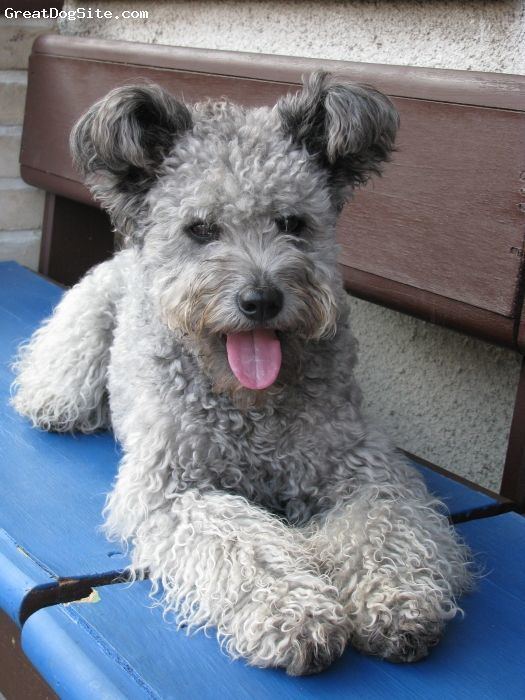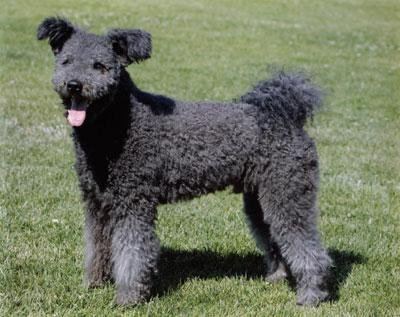AKC Herding Group ANKC Group 5 (Working) Hypoallergenic No Origin Hungary | Herding Group standard Group 5 (Working) standard Life span 12 – 13 years | |
 | ||
Other names Hungarian Pumi
Hungarian herding terrier FCI Group 1, Section 1 Sheepdogs #056 Temperament Lively, Intelligent, Reserved, Protective, Vocal, Active Height Female: 38–44 cm, Male: 41–47 cm Weight Female: 8–13 kg, Male: 10–15 kg Similar Mudi, Puli, Komondor, Bergamasco Shepherd, Schapendoes | ||
The Pumi (in Hungarian, the plural form of pumi is pumik), also known as the Hungarian herding terrier, is a medium-small breed of sheep dog from Hungary. In spite of the fact that some refer to the Pumi as the “Hungarian herding terrier”, there is no terrier blood in the breed; it only means that the Pumi has some terrier-like attributes, such as quick movements, alert temperament, quadratic, lean and muscular body type.
Contents

History
The ancestral Hungarian herding dog appears to have migrated with the Magyars and their livestock from the Ural-Altay region, between China and the Caspian Sea, to the Carpathian Basin around 800 AD, writes Meir Ben-Dror.

This dog most likely can be traced back to the Tibetan herding/guard dogs (Tsang Apso, also mistakenly called terriers by Europeans) originating from China and Tibet and were widespread among various tribes in the region.

The ancestral Puli mixed with French and German herding dogs around 300 years ago, as a result of livestock trade with France and Germany.
In the early twentieth century, the Hungarians identified three separate herding breeds based on phenotype. The Puli was identified first, being prevalent on the eastern Hungarian plains. The Pumi was next, coming from the hills of western Hungary. Then the Mudi last, from southern Hungary. The Pumi was considered a regional variation of the Puli and the two names were used interchangeably for centuries.
Emil Raitsits, had initiated the standardization of Puli and Pumi in the 1910s and 1920s. The Pumi standard was approved by FCI in 1935.
Early breed standards of the Pumi noted the impact of other breeds. This included conformational differences from the Puli, such as the longer muzzle area, the smoother stop line than the Puli's, terrier-like upright ears with tilting top and different coat type.
The Pumi was used to herd cattle, sheep, goats and swine and it is still used today as such. Because livestock was typically kept in the village at night and driven to pasture for the day, the Hungarians needed a dog to work close in and drive livestock to and from pastures, keeping them within the pasture boundaries. The Pumi’s tools were barking, quick movement, and an occasional nip if needed. The Pumi also guarded the farm and alerted its owners when strange people or animals approached. It is usually very vocal and barking shouldn’t be encouraged in most non-farm situations.
Appearance
Most Pumis are gray, and any shade of gray is accepted in the show ring. Gray Pumis are born black but puppies usually start graying at the age of 6 to 8 weeks, and the shade gradually lightens. The final shade can be predicted by the color of the parents. Other accepted colors are black, white, and maszkos fakó, which is cream to red with a darker mask. This color is known as fawn with mask in other breeds in the AKC. The graying often also affects the maszkos fakó Pumi puppies, and the adults are often just slightly shaded. Other colors are possible, but not accepted for shows. Black and tan, brown, blue, and wolf-colored puppies are born occasionally.
The coat is curly, thick, and of medium length, approximately 7 cm (3 inches) long and consisting of a harsh topcoat and soft undercoat. The coat is maintained by combing every few weeks, and trimming every 2 to 4 months. The coat grows constantly (similar to that of the Poodle) and, if grooming is not maintained, the coat may start matting.
This breed has little to no shedding (see Moult).
The Pumi trademark is its ears, which are always alert and very lively. Ears are high-set and the tip bends down. Ears are covered with longer hair than the rest of the body.
The Pumi is a light-bodied, square dog that looks slightly larger than it is because of the thick coat. The Pumi has a long, narrow head. The muzzle is 45% of the length of the head, which is of equal length to the neck. The stop is barely noticeable, and the skull is flat when seen from the side. The eyes are small, dark, and slightly oblique. Movements are lively and energetic, as is the Pumi itself.
Male Pumis stand 41 to 47 cm (16 to 19 in) at the withers and weigh 10 to 15 kg (22 to 33 lb); bitches are 38 to 44 cm (15 to 17 in) and weigh 8 to 13 kg (18 to 29 lb).
Temperament
The Pumi can be very protective of its own family, and often slightly reserved toward strangers, so socialization must begin early. The Pumi is a lively and active breed. It is intelligent but barks easily. Pumis are easy to train.
Health
Pumis are a healthy breed with a life expectancy of 12 to 14 years, but Pumis have been known to live up to 19 years. Known medical problems are patella luxation and canine hip dysplasia.
The most extensive health records of the breed can be found from Finland and Sweden, and around 80% of the Pumis born there have healthy hips.
Activities
The Pumi was originally used as a herding dog, but now, most of them are used for other purposes such as dog agility, dog dancing, and obedience, but also can be trained for detection, search and rescue, and other purposes. Since the Pumi was originally used for herding they are eligible to compete in herding events. Herding instincts and trainability can be measured at noncompetitive herding tests. Pumis that exhibit basic herding instincts can be trained to compete in herding trials. Pumis have been used also for hunting wild boar.
Recognition
The Pumi is relatively unknown outside Hungary, but in Sweden and Finland around 100 Pumis are registered every year. In both countries, the Pumi is a very popular agility dog, and Pumis are seen almost every year in the Championship competition. In Scandinavia, the Pumi is used for obedience and dog dancing competitions.
In 2004 Pumi was accepted to the American Kennel Club Foundation Stock Service program, and the Hungarian Pumi Club of America was founded. Effective January 1, 2011, the Pumi was accepted into the AKC Miscellaneous class. Effective July 1, 2016, the Pumi was accepted into the AKC Herding class.
